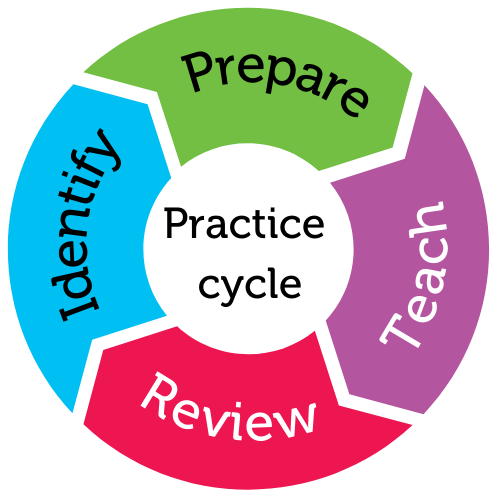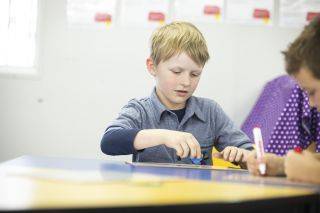
Sustain collaborative partnerships - Collaborative Partnerships in Action
teaching practiceFor student year
Helps students to
- feel connected
- develop positive relationships
Helps teachers to
- identify key stakeholders
- identify student needs
Summary
Students with diverse learning needs require collaborative partnerships with input from a range of stakeholders to meet their learning needs and promote success across the school years.
This practice is the third in a series of three designed to support teachers to establish, value and sustain student-centred collaborative partnerships.
This practice builds on the previous two practices - Establish collaborative partnerships and Value collaborative partnerships - and considers the key facilitators and barriers to sustaining and maintaining collaborative partnerships.
Watch this video to learn more about sustaining collaborative partnerships.
Duration: 3:22
Australian Professional Standards for Teachers related to this practice
4.1 - support student participation
4.3 - manage challenging behaviour
7.3 - engage with the parents/carers
For further information, see Australian Professional Standards for Teachers AITSL page(link is external)
Preparing to teach
Sustaining partnerships
It is not enough to just establish the student centred collaborative partnerships in your school. The partnership also needs to be valued to ensure it can be sustained and maintained long term so you maximise the diverse learners success and provide consistency and a sense of connectedness.
Truly collaborative partnerships are critical if the partnership is to be sustained long term. It is the nature of long-term partnerships and communication that will support the development of either truly collaborative or strained relationships.
The importance of communication in sustainable long-term collaborative partnerships
Communication is core to sustaining student centred collaborative partnerships long-term. There are 3 key communicative elements that need to occur between parents, students and professional to ensure long lasting and sustained student-centred collaborative partnerships can be maintained.
These include ensuring professionals, parents and students continue to keep lines of communication open by:
| Element | Explanation | What you should consider |
|---|---|---|
| Sharing knowledge | Building trust and respect enables stakeholders to share their knowledge and ideas with the CP | How will you give partners the opportunity to share their knowledge, ideas and opinions in the collaboration. |
| Follow up communication | Following up with ongoing communication and check ins between formal and set meetings and establishing what format this communication will take (e.g., home school communication book, emails, phone calls, or a combination of different modes of communication) | How will you follow up after formal meetings with ongoing communication and check ins? |
| Monitoring actions | Following up with planned actions in a timely manner and communicating with other partners about this follow through | What strategies will you put in place to ensure actions are followed through with, reviewed and evaluated? |
These communicative elements build confidence, trust, mutual respect and open communication in the relationships and help to ensure the partnership can be sustained in a truly collaborative manner for the long term.
| Communication and collaboration are closely linked. Communication is a critical tool that facilitates and underpins the sustainability of student-centred collaborative partnerships. |
In the classroom
Step 1 - Download the Sustaining collaborative partnerships information checklist
Step 1 - Download the Sustaining collaborative partnerships information checklist
Download the Sustaining collaborative partnerships checklist (Practice 3)
Sustaining collaborative partnerships checklist
Step 2 - Planning for communication
Before the collaboration starts complete Section 1 of the form planning for communication in the partnership
Consider the following:
- How will you give partners the opportunity in the collaboration to share their knowledge and expertise?
- How will you follow up after formal meetings with ongoing communication and check ins?
- What strategies will you put in place to ensure actions are followed through with?
- How will you communicate this to all partners in a timely fashion?
- How will partners share feedback amongst the team that is respectful?
Step 3 - Collaboration checklist
During the collaboration complete the checklist in Section 2 of the form.
Consider how you will:
- Give each partner the opportunity to share their views on each agenda item for the meeting
- Develop a summary with the team of actions that have been generated from the meeting and a plan for how to action these
- Develop a time frame for actioning these
- Develop a plan with the team for the best way to communicate the results of these actions, in what time frame and in what form this will be communicated
- Provide opportunity at the end of each formal meeting to share feedback and reflect on the collaborative process
- Discuss with the team ideas for the best way to follow up/check in between more formal collaborations
- Set a date for the next formal meeting
Step 4 - Check in with partners
After the collaboration complete the checklist in section 3 of the form.
Consider how you will:
- Keep the team updated about the progress of actions within the time frames discussed in the meeting.
- If there is a delay in actioning things let the team know and provide a new suggested date that these will be actioned, and outcomes reported on
- Send reminders about next meeting date, time and location
- Provide opportunities for the team to contribute to a draft agenda
- Check in regularly with team members less formally
Step 5 - Reflect
Reflect on what you will Start-Stop-Continue in Section 4 of the form
Practice toolkit
Practice implementation planner template
We know it's not always easy to keep track of what's working and what isn't. So, we've created this template for you to record and reflect on what you're doing to create more inclusive classrooms. The implementation planner contains:
- guidance around goal setting
- a reflection section (what worked, didn’t work, what to change, and next steps)
- prompting questions.
Implementation planner with examples
Set your professional learning goal for:
Sustain collaborative partnerships - Collaborative Partnerships in Action
Benefits of goal setting
Setting, working towards, and reflecting on goals helps you grow professionally and improve your practice. You can access AITSL learning resources for teachers to learn more about:How to set goals
The Australian Institute for Teaching and School Leadership recommends using the SMART matrix to frame your goal setting.SMART goals refers to goals that are:
- Specific
- Measurable
- Achievable
- Relevant
- Time-phased
Resources
Sustaining collaborative partnerships
Related Practices

Establish collaborative partnerships - Collaborative Partnerships in Action
TEACHING PRACTICE
For student years
Helps students to
- feel connected
- develop positive relationships

Value collaborative partnerships - Collaborative Partnerships in Action
TEACHING PRACTICE
For student years
Helps students to
- feel connected
- develop positive relationships
This practice is from the core research project
Learning Cycle

